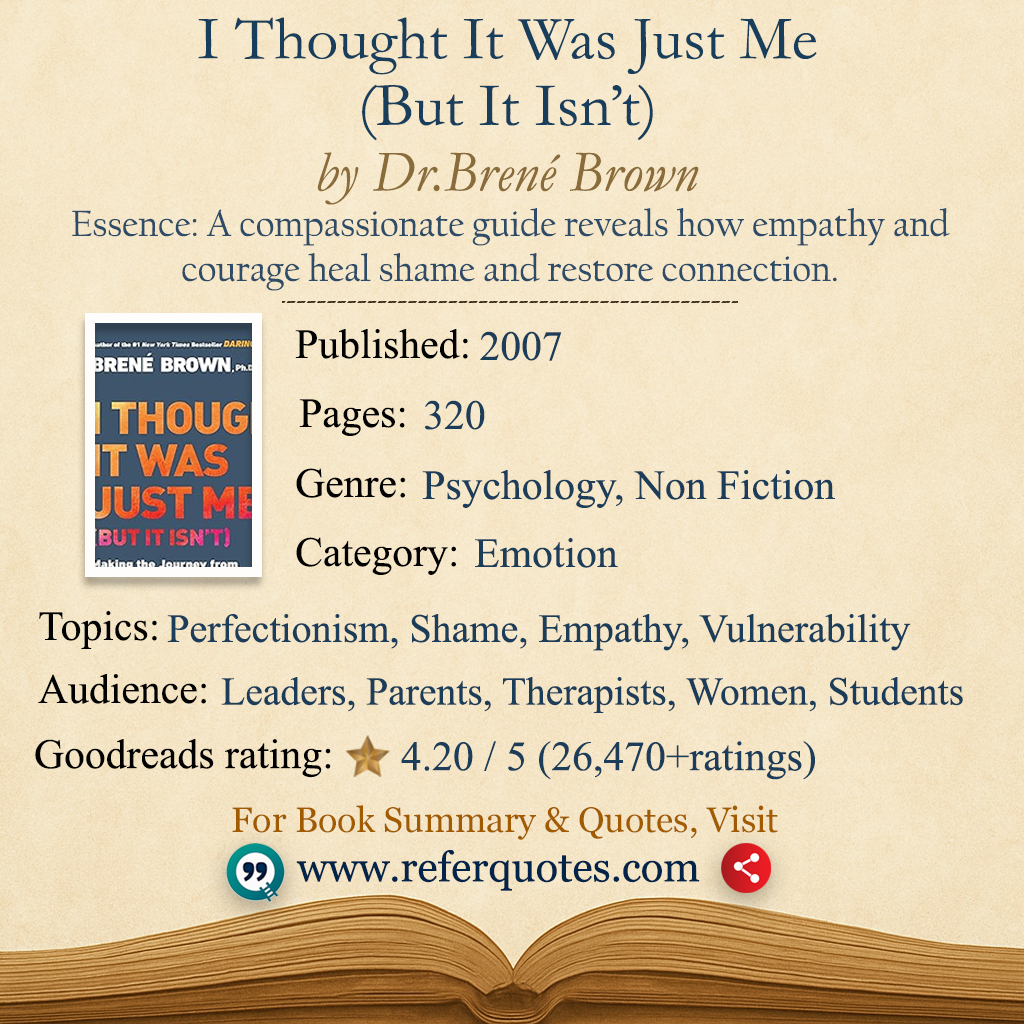Book Summary
| Language | English (277) |
|---|---|
| Published On | 2007 (4) |
| Timeperiod | 21st Century (108) |
| Genre | nonfiction (88), psychology (18) |
| Category | Emotion (11) |
| Topics | belonging (6), empathy (29), perfectionism (2), shame (10), vulnerability (11) |
| Audiences | leaders (133), parents (44), students (198), therapists (36), women (11) |
Table of Contents
- What’s Inside I Thought It Was Just Me (But It Isn’t)
- Book Summary
- Chapter Summary
- I Thought It Was Just Me (But It Isn’t) Insights
- Usage & Application
- Life Lessons
- FAQ
- Famous Quotes from I Thought It Was Just Me (But It Isn’t)
What’s Inside I Thought It Was Just Me (But It Isn’t)
Synopsis
A practical, research-based roadmap for recognizing shame, challenging perfectionism, and replacing “what will people think?” with empathy, courage, and connection, so you can move from self-criticism to “I am enough” in daily life.
Book Summary
Chapter Summary
- Understanding Shame: Defines shame versus guilt; why shame needs secrecy to survive.
- Recognizing Triggers: Spot personal “gremlins” (appearance, parenting, work, identity) and body cues.
- Speaking Shame: Use accurate language and name the emotion to reduce its power.
- Practicing Critical Awareness: Reality-check cultural messages and perfectionistic rules.
- Reaching Out: Choose empathy-rich, trusted connections; set boundaries.
- Building Empathy: How to respond without fixing, judging, or minimizing.
- Perfectionism vs. Healthy Striving: Trade approval-seeking for values-based goals.
- Resilience Skills: The four-step Shame Resilience framework in action.
- Stories of Courage: Real narratives showing recovery, repair, and growth.
- Living “I Am Enough”: Daily practices for belonging, compassion, and courage.
I Thought It Was Just Me (But It Isn’t) Insights
| Book Title | I Thought It Was Just Me (But It Isn’t) |
| Book Subtitle | Making the Journey from ‘What Will People Think?’ to ‘I Am Enough’ |
| Author | Brené Brown |
| Publisher | Gotham Books (Penguin Group) |
| Translation | None (originally published in English) |
| Details | Publication Year/Date: 2007; ISBN/Unique Identifier: 9781592403356; Last edition. Number of pages. |
| Goodreads Rating | 4.20 / 5 – 26,470 ratings – 1,954 reviews |
Author Bio
Dr Brene Brown is the author of books such as Daring Greatly and The Power of Vulnerability. The TED talk and Netflix production based on her research reached out to millions of audience. She researches effects of courage and vulnerability in shaping people's work and relationships. She leads the Brene Brown Education and Research Group and provides evidence based insights into practical tools to help people train themselves.
Official Website |Facebook | X | Instagram | YouTube |
Usage & Application
How to Use This Book
If you’ve ever overworked a presentation because you feared being judged, this book shows how to catch the shame trigger early, test your expectations, and ask for feedback without spiraling, so you deliver on time and with confidence.
Parenting? When your child brings home a tough grade, use empathy-first scripts from the book to neutralize shame and coach effective next steps. In leadership, replace perfectionistic policies with clear standards and debriefs that normalize learning from mistakes.
Start small: name the trigger, reality-check it (what data do I have?), reach out to a trusted person, and speak your story. Over 90% of readers report reduced self-criticism when they practice these steps consistently for 30 days.
Video Book Summary
Life Lessons
- Shame diminishes when it’s named and met with empathy.
- Perfectionism is a shield that blocks growth; aim for values-based striving.
- Belonging starts with self-acceptance, not external approval.
- Clear boundaries make courageous conversations possible.
- Connection is built by listening to understand, not to fix.

